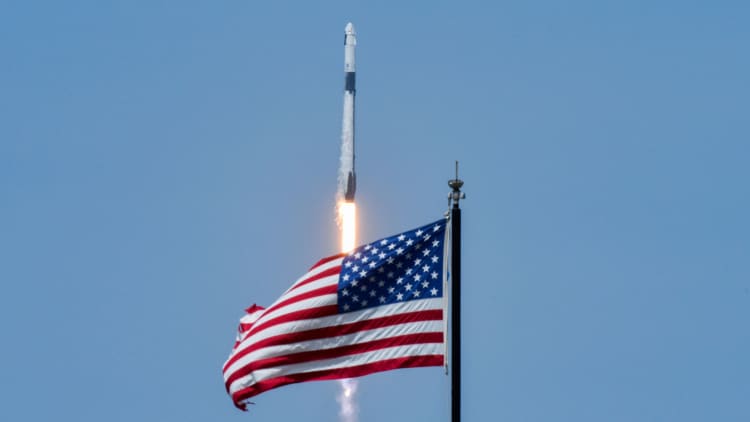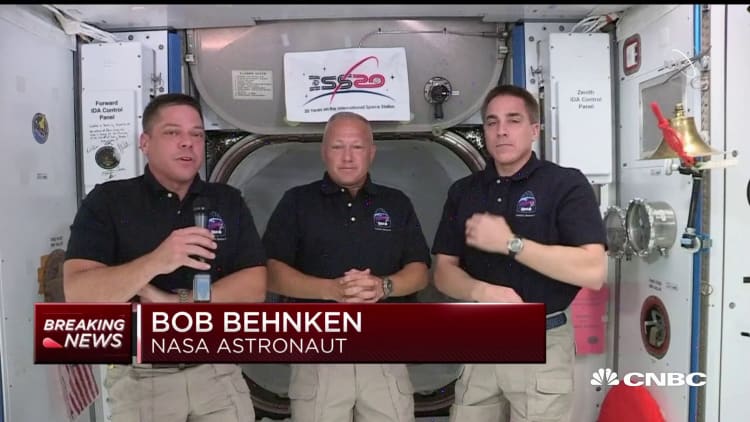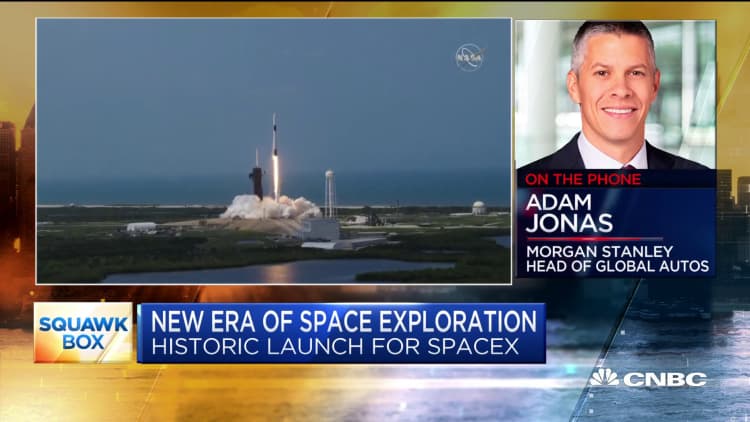
SpaceX launched astronauts to space for first time on Saturday, in a mission heralded by NASA leaders as the beginning of a new chapter in human spaceflight.
"We have been reliant on Russia to ferry astronauts into space since 2011, and this moment puts us back on track with grander ambitions for human space flight ahead of us," Jefferies analyst Sheila Kahyaoglu told CNBC after the launch.
In short, the first crewed SpaceX Demo 2 launch means everything from the U.S. controlling its own future in space to unlocking the possibility of human life on Mars.
The United States has done this before, but it has been some time. NASA put its first man in orbit 58 years ago, landed people on the moon 51 years ago, and began launching the space shuttle to orbit nearly 40 years ago. Those achievements are each certainly historic, but the U.S. has not returned humans to the moon since the Apollo program ended. And ballooning costs, as well as higher-than-anticipated risk, led to the end of the space shuttle program in 2011.
Some of the significance of the SpaceX launch has been buried in the news cycle. NASA officials had hoped that the launch would be a unifying moment for the country. But the SpaceX Demo-2 mission has taken a backseat to the global coronavirus pandemic and widespread U.S. protests following the death of George Floyd in Minneapolis.
NASA astronaut Bob Behnken noted those two situations in a CNBC interview on Tuesday, saying he hopes the view that astronauts have of Earth helps spread an inspiring message.
"There are no boundaries or borders really observable from space. You see that it's a single planet with a shared atmosphere. It's our shared place in this universe," Behnken told CNBC. "I think that perspective, as we go through things like the pandemic or we see the challenges across our nation or across the world, we recognize that we all face them together."
To better capture the importance of last weekend's launch, CNBC spoke to Wall Street analysts, private capital investors and industry experts.
"A private company has just achieved a feat that heretofore has only been achieved by nation-states." Quilty Analytics founder Chris Quilty told CNBC. "The launch unlocks the possibility of a new era of sustained, private, commercial activity in space."
Indeed, the SpaceX Crew Dragon spacecraft is the first to be designed, built and launched to space by a private entity. That's an accomplishment only three nations — the U.S., Russia and China — have achieved previously.
But this success is even bigger for SpaceX, as Morgan Stanley analyst Adam Jonas explained in a note to clients on Monday.
"The primary role of a private commercial space company in the Demo-2 mission is highly significant and defines this new era of space, in our view," Jonas said.
In essence, NASA took a new approach to developing a replacement for the space shuttle when it partnered with SpaceX and Boeing.
Rather than the agency taking the lead on designing and building a spacecraft, with help from contractors, NASA through the Commercial Crew program awarded the two companies with development funds and then worked alongside the companies.
Silicon Valley Bank managing director Ann Kim told CNBC that NASA partnering with SpaceX has led to an unprecedented low price tag for U.S. taxpayers. "Working with domestic partners will produce massive cost savings, increase both public and private funding, and accelerate growth of the US space economy," Kim said.

This model also means that SpaceX retains ownership of the spacecraft it developed, as NASA is procuring services from Elon Musk's company — buying seats for its astronauts. That allows SpaceX to use the Crew Dragon capsules for other missions, such as private passenger flights. This represents a new dynamic in the space industry, Space Capital managing partner Chad Anderson told CNBC.
"Previously, NASA has been both sides of the equation -- they have been the supply and the demand," Anderson said. "You can't have a flourishing marketplace when you only have one actor and only a few companies helping them get there."
The historical significance
Once NASA retired the space shuttle nearly a decade ago, the country was left with "no mechanism for sending astronauts to space, other than to pay for a seat on a Russian rocket," ARK Invest analyst Sam Korus told CNBC. That handed Russia a monopoly on human spaceflight, which Korus noted led to the price NASA paid per astronaut increasing from about $40 million in 2011 to more than $90 million this year.
"This is huge in reclaiming our ability to control our future in space," Korus said.
Analysts used a variety of historical analogies to contextualize why SpaceX's launch matters when the U.S. has done this before. Jefferies' Kahyaoglu looked to baseball, and the end of a storied championship drought, for comparison.
"It is like when the Red Sox won the world series in 2004 after an 86 year drought. They went on to win several more over the next six years. This event puts NASA on track to expand its human space program," Kahyaoglu told CNBC.
Korus and Quilty both gave analogies from the tech industry to compare to the Demo-2 launch. Korus noted that the precursor to the internet was a U.S. military project called ARPANET, which connected the first computers in 1969. Much like the Apollo and space shuttle programs, the ARPANET program was a historic success but was far too costly to run long-term and was decommissioned. But ARPANET paved the way for the commercialization of the internet, which Korus noted has today created trillions of dollars in value.
"Numerous technologies from the semiconductor to the Internet were created [or] established through government investment but did not become economically relevant until commercial actors stepped in," Quilty said, describing the first SpaceX crewed launch as a possible "Netscape Navigator" moment for the space industry.
There are hundreds of private space companies on SpaceX's heels as well, thanks to about $24 billion of investment in the past decade. One of those companies is Axiom Space, which is planning private missions to the ISS as well as its own space station, and is led by CEO Mike Suffredini — who led NASA's space station program for a decade. Suffredini told CNBC that, in addition to the milestones that SpaceX Demo-2 surpassed, the launch of astronauts has a more powerful and inspirational affect on the industry's growth.
"We found in the agency over the years that astronauts had this unique ability to open the imaginations of all of us because we could all imagine ourselves participating." Suffredini said "The key aspect is that now people can relate to it."
What it means for NASA
Beyond President Donald Trump, Vice President Mike Pence and much of this current administration's cabinet, many of NASA's leadership were on hand to witness the SpaceX Demo-2 launch at Kennedy Space Center in Florida. While this launch sent astronauts into orbit around the Earth, Morgan Stanley emphasized that it energizes NASA's plans to send crew further.
"There is a significant sense of urgency to execute bolder and more audacious missions in space," Jonas said. "Advancements in the next 5 to 10 years in space from a commercial, scientific and dual purpose/military perspective appear to be on a course of non-linear growth."
NASA's Commercial Crew program represents a high-profile shift in the way the agency awards funding to companies, as Bessemer Venture Partners vice president Tess Hatch told CNBC.
"This public private partnership has already proven successful since SpaceX has delivered 20 resupply missions to the international space station, but this mission was especially important since it was the first time astronauts, rather than cargo, were on board," Hatch said.
That model of a partnership through a fixed-price development contract is one that each analyst and investor that CNBC spoke to highlighted. Kahyaoglu called it "a pivotal moment" that is in a sense "a blueprint for accelerating timelines."
Kim said that the launch's success "should instill confidence that public-private partnerships are an integral driving force" to NASA's long-term plans. And Anderson described it as "a new way of doing business for NASA and private partners," that makes use of incentives "to push innovation forward."
"What this really represents is a foundational shift in how we operate in space, where NASA is the customer," Anderson added. "They're now applying that partnership model to other things, like the moon."
Quilty Analytics pointed out that NASA awarded SpaceX with about $1.75 billion to develop Crew Dragon. For comparison, the Planetary Society noted that the cost to develop the space shuttle was $27.4 billion in 2020 dollars.
Beyond the comparatively low price to build the spacecraft, Crew Dragon is also expected to be the most cost-effective spacecraft to carry astronauts. NASA awarded SpaceX with $2.4 billion for six operational missions. Dividing those up, each Crew Dragon launch costs about $400 million, with $220 million of that cost allotted to the four astronauts NASA expects to fly per mission — or $55 million per astronaut.
For comparison, Quilty estimated that the space shuttle cost $1.75 billion per launch when adjusted for inflation — more than four times as much. NASA even said it expects the Commercial Crew program will save U.S. taxpayers more than $20 billion compared to the agency's previously plan for flying astronauts to the ISS.
"The launch represents yet another ... nail in the heavy-handed government-led approach of developing space hardware," Quilty said.
NASA asked Congress for a $25.2 billion budget next year. Anderson believes that the cost savings from programs like Commercial Crew will allow NASA "to take those savings and put them into other space missions."
"Things that are pushing the boundaries and helping us go farther and explore more distant places that we never had before," Anderson said.
What it means for SpaceX
For Musk's rocket builder, the Demo-2 mission represents the culmination of the company's work thus far. Musk founded the company in 2002 and has since declared its informal credo to be "making humanity a multi-planetary species." To date, SpaceX has launched dozens of satellites and spacecraft successfully with its Falcon 9 and Falcon Heavy rockets. But, before Saturday, it had never put a human in space.
"They have revolutionized the launch vehicle market through manufacturing and higher volume which has allowed for more cost effective solutions for customers," Kahyaoglu said. "This is one step in terms of evolution and potential application for human space affordability. It is about pushing the limits further than before, but also trying to do it at a lower cost."

Quilty also noted that flying astronauts represents "a significant new revenue opportunity for SpaceX."
"That can help fund the company's sprawling ambitions and activities," Quilty said.
Suffredini's Axiom is one such SpaceX client, as the two companies signed a deal in March to fly three privately paying space tourists to the ISS for a 10-day mission. The mission will be managed by Axiom and will utilize SpaceX's Crew Dragon capsule in what is expected to be "the first-ever fully private" trip to the space station. Suffredini told CNBC that he's worked with Musk and SpaceX president Gwynne Shotwell for many years and believes the Demo-2 launch is "really energizing to the company" as a whole.
"I think it's very moving for them, as a bunch of individuals working for the company, to say that 'nobody's done this before,'" Suffredini said.
Axiom's first flight to the space station is scheduled for October 2021. Until SpaceX's first crewed launch, Suffredini said Axiom has had "customers kind of sitting on the sidelines," waiting for SpaceX to begin launch astronauts. The milestone helps "our customers know that it's going to be real," Suffredini added. He said the three passengers for Axiom's first launch have been identified and that the company plans to announce the crew in the next month or so.
Additionally, Suffredini said Axiom is already talking to customers about the company's second and third flights, as "we do intend to fly about once every six months."
But the plans of companies like Axiom would not be possible if it wasn't for SpaceX's success last weekend.
"By proving they can launch humans safely into space, the company unlocks an endless realm of possibilities that can ultimately lead to human life on Mars," Kim said.
Subscribe to CNBC PRO for exclusive insights and analysis, and live business day programming from around the world.


